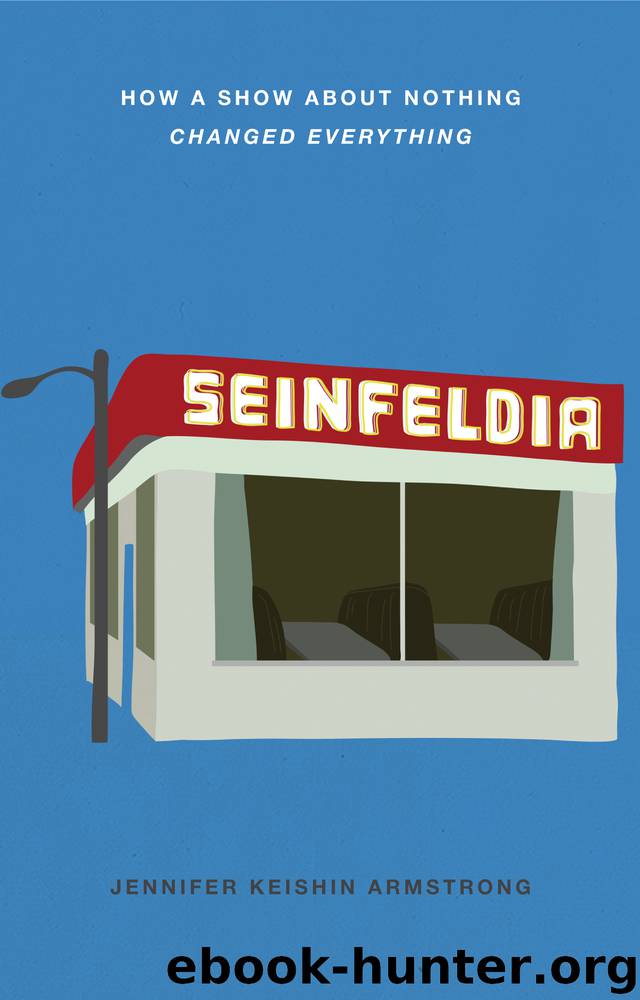Seinfeldia by Jennifer Keishin Armstrong

Author:Jennifer Keishin Armstrong
Language: eng
Format: epub, mobi
Publisher: Simon & Schuster
EVERYTHING SEINFELD DID NOW TOOK on grand significance.
Given the show’s precarious early life—and NBC’s specific concerns about its Jewishness—David and Seinfeld didn’t go out of their way to send their main characters to synagogue or quote the Torah every week. But the Floridian parents, the marble ryes, the Jewish singles events—one couldn’t miss that the title star of the show and more than half of its writers were Jewish. But as the series gained more viewers, the criticisms mounted: Too Jewish. Not Jewish enough. Even “too self-hatingly Jewish,” according to Washington Post critic Tom Shales. Shales cited the show’s parade of nefarious Jewish characters. Elaine’s rabbi neighbor spills his confidants’ secrets. Jerry and his girlfriend make out during Schindler’s List. Elaine, a non-Jewish character, discovers her “shiksappeal” that attracts Jewish men.
In 1996, scholars at a Stanford University Jewish Studies symposium debated the show’s merits for their own culture. Any Jewish identity in mainstream culture was a positive development, said Richard Siegel, the executive director of the National Foundation for Jewish Culture. For author of New York Jew Alfred Kazin, however, neither Seinfeld nor novelist Philip Roth made the cut in terms of representing true Jewish culture. To him, a representation wasn’t sufficiently Jewish unless it dealt with a relationship to God. Stanford religious studies professor Arnold Eisen agreed, comparing Seinfeld to “bagels and lox, which are no longer Jewish.” In an interview at another time, Rabbi Jonathan Pearl of the Jewish Televimages Resource Center complained that Seinfeld became “unfunny” whenever it dealt with Jewish issues.
Alexander, who’s also Jewish, didn’t disagree when it came to one fifth-season episode called “The Bris.” He hated the character of the mohel who circumcises Elaine’s friend’s child. Alexander said, “You have to go a long way to hit my Jew button. To me, this was anti-Semitic in a hurtful way.” He told David he’d have to boycott the episode and persuaded David to soften the portrayal. (In the end, the mohel was merely incompetent, rather than blatantly offensive.) Alexander was never comfortable with the episode, but he could live with it.
Still, the show did bring bits of Jewish culture to the masses in America, many of whom—particularly in the Midwest—barely knew what Hanukkah was.
Writer Steve Koren worked a story line into one of his first scripts about a kid trying to kiss Elaine at his bar mitzvah because he’s “a man now.” Unlike at Saturday Night Live, however, Koren knew this wasn’t enough to support an episode. He was right: Seinfeld liked the concept but said, “What else, what else?” Koren came up with several versions of the story, but none quite worked. He had that story on the bulletin board in his office for a year before he realized: The kid renounces Judaism for Elaine.
With that, the bar mitzvah kid made it into Koren’s favorite of the episodes he wrote, “The Serenity Now.” It was, if anything, Seinfeld doing the exact opposite of renouncing Judaism; for one of the few times in its run,
Download
This site does not store any files on its server. We only index and link to content provided by other sites. Please contact the content providers to delete copyright contents if any and email us, we'll remove relevant links or contents immediately.
| Coloring Books for Grown-Ups | Humor |
| Movies | Performing Arts |
| Pop Culture | Puzzles & Games |
| Radio | Sheet Music & Scores |
| Television | Trivia & Fun Facts |
Robin by Dave Itzkoff(2411)
Head of Drama by Sydney Newman(2274)
I'm Judging You by Luvvie Ajayi(2177)
The Paranormal 13 (13 free books featuring witches, vampires, werewolves, mermaids, psychics, Loki, time travel and more!) by unknow(2070)
Ten by Gretchen McNeil(1856)
Single State of Mind by Andi Dorfman(1791)
#MurderTrending by Gretchen McNeil(1637)
Key to the Sacred Pattern: The Untold Story of Rennes-le-Chateau by Henry Lincoln(1613)
Merv by Merv Griffin(1599)
Most Talkative by Andy Cohen(1570)
This Is Just My Face by Gabourey Sidibe(1452)
Notes from the Upside Down by Guy Adams(1447)
The Hunger Games: Official Illustrated Movie Companion by Egan Kate(1411)
Springfield Confidential by Mike Reiss(1391)
Binging with Babish by Andrew Rea(1377)
Jamie Oliver by Stafford Hildred(1374)
The TV Writer's Workbook: A Creative Approach To Television Scripts by Ellen Sandler(1329)
Clarkson--Look Who's Back by Gwen Russell(1325)
Blue Planet II by James Honeyborne & Mark Brownlow(1260)
